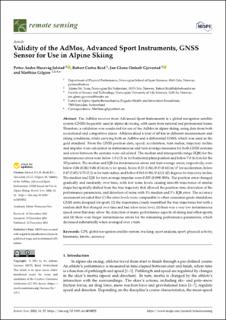| dc.description.abstract | The AdMos receiver from Advanced Sport Instruments is a global navigation satellite system (GNSS) frequently used in alpine ski racing, with users from national and professional teams. Therefore, a validation was conducted for use of the AdMos in alpine skiing, using data from both recreational and competitive skiers. Athletes skied a total of 60 km in different measurement and skiing conditions, while carrying both an AdMos and a differential GNSS, which was used as the gold standard. From the GNSS position data, speed, acceleration, turn radius, trajectory incline and impulse were calculated as instantaneous and turn average measures for both GNSS systems and errors between the systems were calculated. The median and interquartile range (IQR) for the instantaneous errors were below 3.5 (3.5) m for horizontal plane position and below 7.0 (4.3) m for the 3D position. The median and IQR for instantaneous errors and turn average errors, respectively, were below 0.04 (0.24)/0.04 (0.16) m/s for speed, below 0.23 (1.06)/0.35 (0.63) m/s2 for acceleration, below 0.47 (5.65)/0.73 (5.3) m for turn radius, and below 0.043 (1.96)/0.42 (1.42) degrees for trajectory incline. The median and IQR for turn average impulse were 0.025 (0.099) BWs. The position error changed gradually and randomly over time, with low noise levels causing smooth trajectories of similar shape but spatially shifted from the true trajectory that allowed the position–time derivation of the performance parameters, and detection of turns with 3% median and 5% IQR error. The accuracy assessment revealed that (1) the error levels were comparable to other consumer-grade standalone GNSS units designed for sport; (2) the trajectories closely resembled the true trajectories but with a random shift that changed over time and had a low noise level; (3) there was a very low instantaneous speed error that may allow the detection of many performance aspects of skiing and other sports; and (4) there were larger instantaneous errors for the remaining performance parameters, which decreased substantially when averaged over a turn. | |
